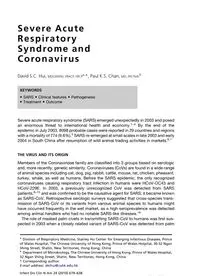
2010 Severe Acute Respiratory Syndrome and Coronavirus PDF
Preview 2010 Severe Acute Respiratory Syndrome and Coronavirus
Severe Acute Respiratory Syndrome and Coronavirus David S.C. Hui, MD(UNSW), FRACP, FRCPa,*, Paul K.S. Chan, MD, FRCPathb Severe acute respiratory syndrome (SARS) emerged unexpectedly in 2003 and posed an enormous threat to international health and economy.1–4 By the end of the epidemic in July 2003, 8098 probable cases were reported in 29 countries and regions with a mortality of 774 (9.6%).5 SARS re-emerged at small scales in late 2003 and early 2004 in South China after resumption of wild animal trading activities in markets.6,7 THE VIRUS AND ITS ORIGIN Members of the Coronaviridae family are classified into 3 groups based on serologic and, more recently, genetic similarity. Coronaviruses (CoVs) are found in a wide range of animal species including cat, dog, pig, rabbit, cattle, mouse, rat, chicken, pheasant, turkey, whale, as well as humans. Before the SARS epidemic, the only recognized coronaviruses causing respiratory tract infection in humans were HCoV-OC43 and HCoV-229E. In 2003, a previously unrecognized CoV was detected from SARS patients,8–15 and was confirmed to be the causative agent for SARS; it became known as SARS-CoV. Retrospective serologic surveys suggested that cross-species trans- mission of SARS-CoV or its variants from various animal species to humans might have occurred frequently in the wet market, as a high seroprevalence was detected among animal handlers who had no notable SARS-like illnesses.16 The role of masked palm civets in transmitting SARS-CoV to humans was first sus- pected in 2003 when a closely related variant of SARS-CoV was detected from palm a Division of Respiratory Medicine, Stanley Ho Center for Emerging Infectious Diseases, Prince of Wales Hospital, The Chinese University of Hong Kong, Prince of Wales Hospital, 30-32 Ngan Shing Street, Shatin, New Territories, Hong Kong, China b Department of Microbiology, The Chinese University of Hong Kong, Prince of Wales Hospital, 32 Ngan Shing Street, Shatin, New Territories, Hong Kong, China * Corresponding author. E-mail address:
